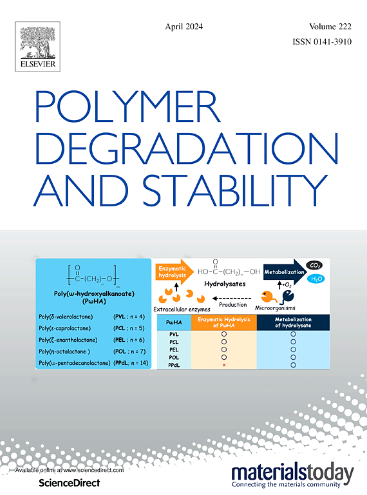填充碳黑的聚氯丁烯的海洋耐久性:海水老化对网络、拉伸和疲劳性能的影响
IF 6.3
2区 化学
Q1 POLYMER SCIENCE
引用次数: 0
摘要
随着海洋可再生能源的发展,海上材料的耐久性比以往任何时候都更成为降低海上设备故障风险的主要问题。在这种恶劣的环境中,弹性体,尤其是聚氯丁烯(CR),因其良好的阻尼和疲劳性能而得到广泛应用。然而,这些材料在使用过程中会发生老化,导致其机械性能发生变化。尽管需要预测部件的使用寿命,但这些材料在海洋环境中的老化尚未得到广泛研究。本文研究了碳黑填充 CR 在暴露于海水时的机械和微观结构退化后果。为此,对之前在天然海水中进行加速老化的材料进行了膨胀、单轴拉伸和疲劳测试。研究特别关注了解其中涉及的物理化学现象,并分析与大分子网络相关的断裂和疲劳特性。本文章由计算机程序翻译,如有差异,请以英文原文为准。
Marine durability of carbon black-filled polychloroprene: Effect of seawater ageing on network, tensile and fatigue properties
With the development of marine renewable energies, the durability of materials at sea is more than ever a major issue in reducing the risk of failure of offshore devices. In this aggressive environment, elastomers, and in particular polychloroprene (CR), have many applications because of their good damping and fatigue properties. However, these materials are subject to ageing in service, which leads to changes in their mechanical properties. The ageing of these materials in a marine environment has not been extensively studied, despite the need to predict components lifetimes. This paper investigates the mechanical and microstructural consequences of a carbon black-filled CR degradation when exposed to seawater. To this end, swelling, uniaxial tensile and fatigue tests are carried out on materials previously subjected to accelerated ageing in natural seawater. Particular attention is paid to understanding the physico-chemical phenomena involved, and analysing fracture and fatigue properties in relation to those of the macromolecular network.
求助全文
通过发布文献求助,成功后即可免费获取论文全文。
去求助
来源期刊

Polymer Degradation and Stability
化学-高分子科学
CiteScore
10.10
自引率
10.20%
发文量
325
审稿时长
23 days
期刊介绍:
Polymer Degradation and Stability deals with the degradation reactions and their control which are a major preoccupation of practitioners of the many and diverse aspects of modern polymer technology.
Deteriorative reactions occur during processing, when polymers are subjected to heat, oxygen and mechanical stress, and during the useful life of the materials when oxygen and sunlight are the most important degradative agencies. In more specialised applications, degradation may be induced by high energy radiation, ozone, atmospheric pollutants, mechanical stress, biological action, hydrolysis and many other influences. The mechanisms of these reactions and stabilisation processes must be understood if the technology and application of polymers are to continue to advance. The reporting of investigations of this kind is therefore a major function of this journal.
However there are also new developments in polymer technology in which degradation processes find positive applications. For example, photodegradable plastics are now available, the recycling of polymeric products will become increasingly important, degradation and combustion studies are involved in the definition of the fire hazards which are associated with polymeric materials and the microelectronics industry is vitally dependent upon polymer degradation in the manufacture of its circuitry. Polymer properties may also be improved by processes like curing and grafting, the chemistry of which can be closely related to that which causes physical deterioration in other circumstances.
 求助内容:
求助内容: 应助结果提醒方式:
应助结果提醒方式:


